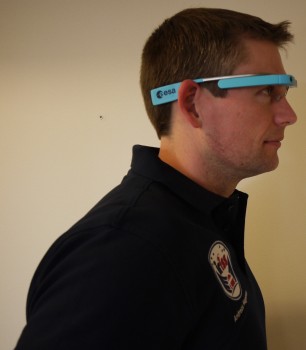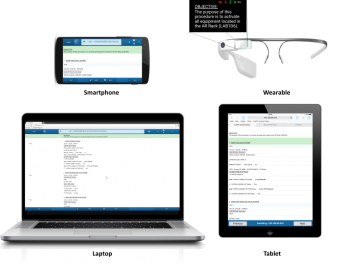Today’s mobiPV experiment for iriss will be one of the last Andreas does on the International Space Station – this time. The team behind the technology demonstration introduce their hardware that they have prepared for space testing:
Wow! We cannot believe we’re at the European Astronaut Centre waiting to watch Andreas Mogensen use our mobiPV system live on the International Space Station! As developers, we have sweated it out to make sure every piece of hardware and software has passed the challenging process of space qualification. Now seeing the system actually on the Space Station is an awesome feeling!
mobiPV, or mobile Procedure Viewer, is a wearable system that does many things. Its primary purpose is to allow our astronauts to access and execute science experiment procedures on-the-go instead of being on a traditional laptop at a fixed location. With mobiPV procedures can be viewed hands free on a wrist-mounted smartphone and on an iPad and with a heads up using Google Glass (yeah! the first to ever fly out of Earth’s atmosphere).
mobiPV also enables astronauts to stream their view to the ground while doing their tasks. In addition the the ground terminal shows an exact mirror of the steps astronauts are working on – so the ground specialists are fully aware of their tasks progress. Astronauts and Flight Controllers can send each other text, audio, video or picture notes with any step to help make science better in the future. Full two-way audio or video on demand is a nice bonus. Just imagine this: mobiPV data goes from the mobiPV ground segment at the European Astronaut Centre in Cologne, Germany, to Huntsville, USA, then to White Sands, USA, and then through the TDRSS satellite network to the International Space Station and then back again! All this take just 900 milliseconds. This complex network allows astronauts and ground control to share procedure steps, photos, videos, text messages and live streams enabling a truly mobile collaboration and communication solution for the crew.
mobiPV was recently used in NASA’s Neemo 19 and Neemo 20 missions where it was a big success. The project has been a fantastic engineering experience – all the way from user experience workshops and app development to qualifying hardware, usability reviews and end-to-end testing.
We are positive that the crew in space will love mobiPV and will want to make it a part of their operations toolbox! A big thanks to ESA’s Astronaut Corps and the European Astronaut Centre (EuroComs Antonio & Andrea and astronaut trainers Bernd and Olivier) for all their inputs during mobiPV’s design (and for bearing with us in all the development phases! ) and our ESA-ESTEC Project Manager Mikael Wolff plus ESTEC Engineer David Oliveira for making this project happen.
#HandsFree #mobiPV
Keshav, Boris, Luka, Xavier, Francesco, Mauro, Martin and Karl
The mobiPV development team from Space Applications Services and Skytek.




Discussion: no comments